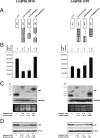Members of a large retroposon family are determinants of post-transcriptional gene expression in Leishmania
- PMID: 17907803
- PMCID: PMC2323293
- DOI: 10.1371/journal.ppat.0030136
Members of a large retroposon family are determinants of post-transcriptional gene expression in Leishmania
Abstract
Trypanosomatids are unicellular protists that include the human pathogens Leishmania spp. (leishmaniasis), Trypanosoma brucei (sleeping sickness), and Trypanosoma cruzi (Chagas disease). Analysis of their recently completed genomes confirmed the presence of non-long-terminal repeat retrotransposons, also called retroposons. Using the 79-bp signature sequence common to all trypanosomatid retroposons as bait, we identified in the Leishmania major genome two new large families of small elements--LmSIDER1 (785 copies) and LmSIDER2 (1,073 copies)--that fulfill all the characteristics of extinct trypanosomatid retroposons. LmSIDERs are approximately 70 times more abundant in L. major compared to T. brucei and are found almost exclusively within the 3'-untranslated regions (3'UTRs) of L. major mRNAs. We provide experimental evidence that LmSIDER2 act as mRNA instability elements and that LmSIDER2-containing mRNAs are generally expressed at lower levels compared to the non-LmSIDER2 mRNAs. The considerable expansion of LmSIDERs within 3'UTRs in an organism lacking transcriptional control and their role in regulating mRNA stability indicate that Leishmania have probably recycled these short retroposons to globally modulate the expression of a number of genes. To our knowledge, this is the first example in eukaryotes of the domestication and expansion of a family of mobile elements that have evolved to fulfill a critical cellular function.
Conflict of interest statement
Figures











Similar articles
-
Trypanosomatid genomes contain several subfamilies of ingi-related retroposons.Eukaryot Cell. 2009 Oct;8(10):1532-42. doi: 10.1128/EC.00183-09. Epub 2009 Aug 7. Eukaryot Cell. 2009. PMID: 19666780 Free PMC article.
-
Organization and evolution of two SIDER retroposon subfamilies and their impact on the Leishmania genome.BMC Genomics. 2009 May 22;10:240. doi: 10.1186/1471-2164-10-240. BMC Genomics. 2009. PMID: 19463167 Free PMC article.
-
Evolution of non-LTR retrotransposons in the trypanosomatid genomes: Leishmania major has lost the active elements.Mol Biochem Parasitol. 2006 Feb;145(2):158-70. doi: 10.1016/j.molbiopara.2005.09.017. Epub 2005 Oct 10. Mol Biochem Parasitol. 2006. PMID: 16257065
-
Unveiling the intracellular survival gene kit of trypanosomatid parasites.PLoS Pathog. 2014 Dec 4;10(12):e1004399. doi: 10.1371/journal.ppat.1004399. eCollection 2014 Dec. PLoS Pathog. 2014. PMID: 25474314 Free PMC article. Review.
-
Signalling the genome: the Ras-like small GTPase family of trypanosomatids.Trends Parasitol. 2005 Oct;21(10):447-50. doi: 10.1016/j.pt.2005.08.008. Trends Parasitol. 2005. PMID: 16112905 Review.
Cited by
-
Transgenic, fluorescent Leishmania mexicana allow direct analysis of the proteome of intracellular amastigotes.Mol Cell Proteomics. 2008 Sep;7(9):1688-701. doi: 10.1074/mcp.M700343-MCP200. Epub 2008 May 12. Mol Cell Proteomics. 2008. PMID: 18474515 Free PMC article.
-
Genome evolution in trypanosomatid parasites.Parasitology. 2015 Feb;142 Suppl 1(Suppl 1):S40-56. doi: 10.1017/S0031182014000894. Epub 2014 Jul 28. Parasitology. 2015. PMID: 25068268 Free PMC article. Review.
-
RNA secondary structure and nucleotide composition of the conserved hallmark sequence of Leishmania SIDER2 retroposons are essential for endonucleolytic cleavage and mRNA degradation.PLoS One. 2017 Jul 13;12(7):e0180678. doi: 10.1371/journal.pone.0180678. eCollection 2017. PLoS One. 2017. PMID: 28704426 Free PMC article.
-
The Pumilio-domain protein PUF6 contributes to SIDER2 retroposon-mediated mRNA decay in Leishmania.RNA. 2017 Dec;23(12):1874-1885. doi: 10.1261/rna.062950.117. Epub 2017 Sep 6. RNA. 2017. PMID: 28877997 Free PMC article.
-
Novel insights into the Leishmania infantum transcriptome diversity of protein-coding and non-coding sequences in both stages of parasite development using nanopore direct RNA sequencing.BMC Genomics. 2025 Jul 1;26(1):573. doi: 10.1186/s12864-025-11767-8. BMC Genomics. 2025. PMID: 40597600 Free PMC article.
References
-
- Haag J, O'Huigin C, Overath P. The molecular phylogeny of trypanosomes: Evidence for an early divergence of the Salivaria. Mol Biochem Parasitol. 1998;91:37–49. - PubMed
-
- Berriman M, Ghedin E, Hertz-Fowler C, Blandin G, Renauld H, et al. The genome of the African trypanosome Trypanosoma brucei. Science. 2005;309:416–422. - PubMed
-
- El-Sayed NM, Myler PJ, Bartholomeu DC, Nilsson D, Aggarwal G, et al. The genome sequence of Trypanosoma cruzi, etiologic agent of Chagas disease. Science. 2005;309:409–415. - PubMed
Publication types
MeSH terms
Substances
Grants and funding
LinkOut - more resources
Full Text Sources
Other Literature Sources
Miscellaneous

